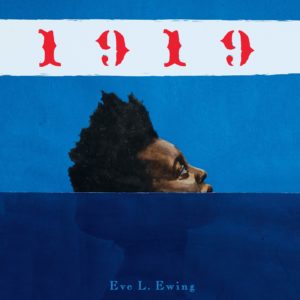
At this point, it’s fair to question whether or not Eve Ewing sleeps. 1919 is her third book published since 2017, coming on the heels of Electric Arches, her debut poetry collection, and Ghosts in the Schoolyard: Racism and School Closings on Chicago’s South Side. Oh, and there’s this comic book she’s writing titled Ironheart, about Riri Williams, a young black woman who reverse-engineered Tony Stark’s Iron Man suit. And, she’s one of the best follows on Twitter.
This space, however, is not for me to be fanboying over amazing writers (though I often do that, admittedly). It’s for me to tell you why I chose this specific book, so here’s why: We do a shit job in this country teaching and learning and talking about our legacy of racism, and how we’re struggling—and failing—to deal with it today. That’s by design, whether we’re talking about the way the Lost Cause reimagined Southern traitors who were defending their right to own slaves as defenders of their homes against aggressive invaders, or ignoring the practice of redlining and the way banks often charge higher interest rates for mortgages to people of color whose credit scores qualify them for lower rates, or the inequitable ways our public schools are funded and segregated. We don’t talk about lynching or race riots or the Great Migration(s) or housing covenants much, and when we do, it’s usually with distance, as though these things happened so long ago that they’re an abstraction or a curiosity.
Before I tell you more, a quick reminder that in order to receive your early copy of 1919, read along with the Poetry Book Club, and participate in our exclusive chat with Eve L. Ewing, you’ll need to subscribe by April 20!
The primary event in 1919 is a race riot in Chicago. Ewing drew from a lot of sources in creating this collection, most notably a report from 1922 titled, as she mentions in the book’s opening moment, The Negro in Chicago: A Study on Race Relations and a Race Riot, but also from the Bible’s Book of Exodus, Langston Hughes, double dutch, Hannah Arendt, and more. That aforementioned report was an attempt by “a committee appointed by the governor, made up of six Black men and six White men, all deemed by their peers to be upstanding and respectable citizens… to dissect the 1919 race riot… to analyze its causes and try to prevent something like that from happening again.” Ewing uses this report as a jumping off point to create the poems in this collection.
But don’t be mistaken—1919 isn’t a history book. These are poems, crafted and tense, inventive and full of energy. For example, the poem “or does it explode,” which takes its name from the closing line of Langston Hughes’s poem “Harlem,” is a call and response that starts with an insult joke:
man it was so hot
how hot was it
it was so hot
you could cook an egg
on that big forehead of your
you a lie
and ends with
it was so hot
our dreams laid out on the sidewalk
and said ’never mind, we good’
which takes us back to the opening line of Hughes’s poem, “What happens to a dream deferred?”
Turn the page and the very next poem, “Jump / Rope,” pulls from double dutch chants, with different voices interrupting each other with “no, it goes like” as they compete to tell the story of Eugene Williams, the seventeen-year-old who drowned while swimming in Lake Michigan, perhaps because he was hit by a rock thrown by White people on the beach, or perhaps because he was afraid to come to shore and be attacked. The juxtaposition of the form and the subject of the song is jarring, and that’s what makes the poem work.
All this and I haven’t even gotten into the way Ewing echoes the Book of Exodus or the included historical photographs which add visual depth to the book. I hope you’ll join us in May as we read and discuss 1919, first together and then with Eve L. Ewing in our exclusive online chat. Subscribe to the Rumpus Poetry Book Club by April 20 to make sure you don’t miss out!




